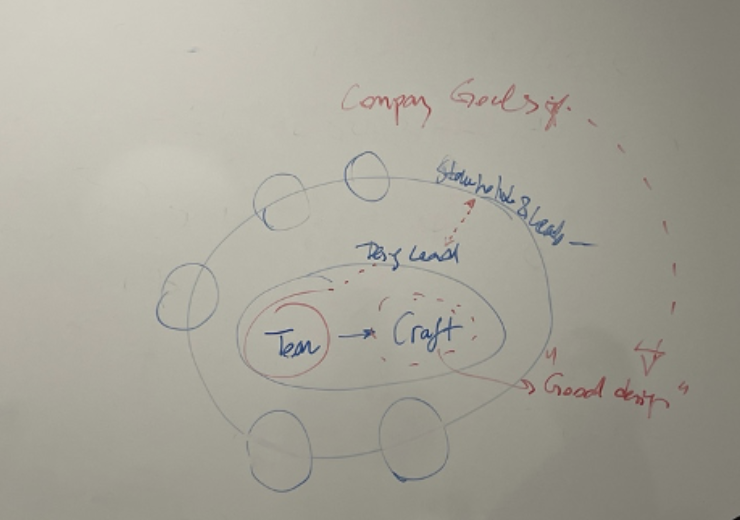The Design Leadership Community is meeting different design leaders in Sweden and listening to their stories about their career and leadership. The fifth interviewee is Pelin Arslan, UX Manager at Volvo Cars. In this interview, Terry Han is meeting Pelin to talk about her journey as a design leader with her open-heart people-centric leadership.
I believe design leaders must be empathetic to the team and stakeholders. And it is very much important to be good at understanding the purposes and drives people have.
Pelin
Terry: Can you introduce yourself?
Pelin: I’m Pelin. I’m a design leader in automotive and digital platforms with 12 years of experience, and I’ve held various roles throughout my career in research, software (HCI) and healthcare. I started as an industrial designer at first. Then I specialized in services and systems of design because I was very curious about how I can create impact. To create impact, you really need to understand the ecosystem, and I got fascinated by it. Throughout my career, I started moving toward digital design where some of my experiences, including my time at MIT, Autodesk and other organizations.

Terry: Can you describe your current role and responsibilities?
Pelin: I’m right now, UX manager at Volvo Cars. My team is responsible for designing multimodal experiences to make sure that the people are able to drive safely and sustainably. Therefore, it is essential for us to think about the user journey from end to end. From the moment the users start driving the car to the moment that they go through different driving scenarios and transitions to automated systems. It can include using a driving assistance function, parking, or charging the car.
Terry: What’s your main work scope? What do you do daily at work?
Pelin: I’m part of a wider UX organization which is positioned in the Global Design Team. I lead the design teams, overseeing the design work while also serving as a people manager. My main role is to support and guide the team’s everyday work towards our strategic design vision and company goals. I strive to establish clear goals and priorities for the designers while setting high standards for design quality. One of my responsibilities is to make sure our partners are aware of the value we bring and the great work we do as a team. I also ensure we have a meaningful voice in various stakeholder meetings. For instance, in leadership or strategic program meetings, I speak for the user, advocate for design and communicate the value of UX in discussions. I believe in my role, it is critical to build good relationships both with our teams and partners for better collaboration, alignment and understanding.
Terry: How does your team look? How many people do you manage?
Pelin: Now I am managing around 22 designers. I have three teams, and each team has responsibilities which eventually have a strong connection to each other to create a seamless user experience across the user journey. So, I call them as a cluster or connecting pieces where different teams need to collaborate on a common mission.
My role is to enable collaboration within the group. To facilitate this, we hold weekly team reviews where each designer presents their work for peer feedback. We encourage everyone to appreciate diverse perspectives, as this is crucial for creating an inclusive environment. Our team is incredibly diverse, boasting more than 10 nationalities. This brings a range of experiences, cultures, and skills. While everyone has a foundation in UX design and excels at understanding users and their problems, each designer also has unique skills. Some excel in visual design, while others have a stronger research background.
Terry: How do you define the role of the design leader?

Pelin: Design leader is the person who helps the team to craft a good design and deliver it to the different stakeholders and leaders.
The first one is the people part. For the people part, the design leader needs to take care of the team. For that, they must make sure that they create the right and safe environment for the team to do their best work with bringing their best of themselves. So that they feel safe to bring their ideas and feedback. In addition, the design leader needs to help team members elevate their skills and thinking.
Secondly, for the craft part, the design leader should define what good design is and establish its characteristics. The good design should be aligned with the goals and the vision of the company. They need to ensure design is set up for success by defining challenges, milestones and setting measures of success. They have to set the expectations on goals and processes and empower designers to make great design decisions.
Thirdly, it is about the relationships. The design leader has to be an advocate of the design who amplifies the design in different pockets on the different meetings with stakeholders. The role of the design leader here is to represent and propose design solutions and make stakeholders either buy in or have a healthy debate about them.
Terry: When did you actually start to define yourself as a design leader?
Pelin: Currently, I am holding a managerial position, but I identified myself as a design leader long before I joined this company. During my time at MIT, I led a design project aiming to envision human-centric scenarios for the future of smart cities with a team of researchers and graduates. We established the project’s vision and process. As the team leader, I guided the team in formulating our goals. Although I wasn’t managing them, I was operating as a design leader, encouraging everyone to work towards our shared objectives. This strengthened my skills and enabled me to take other roles in leadership at Autodesk.
Terry: What kind of design leader do you think you are like?
Pelin: I see myself as a very people-centric design leader. I am a leader who tries hard to connect deeply with the people and understand their values and goals. I believe design leaders must be empathetic to the team and stakeholders. And it is very much important to be good at understanding the purposes and drives people have. Because their inner driving force helps us to scale their impact, elevate their contribution and enables us to grow together.
Terry: Actually, you’re the first female leader I am interviewing who’s not Swedish, so it could be interesting for me to have a peak of that aspect from you. Did you notice any cultural differences or struggle, such as from the organization or communication?
Pelin: Really interesting question! I have not really thought about it, honestly. Maybe I was lucky enough to work in an international environment at Volvo Cars. On reflection though, I’ve noticed that some people tend to hold back, not expressing their thoughts openly. It can be challenging to understand what they’re thinking.
Being aware of cultural nuances is important, both in terms of the overall organizational culture and any specific cultural differences that may exist within a diverse team. In order to build the right relationships, you need to foster a culture of mutual respect and support. This can be possible by embracing diverse perspectives and creating a harmonious environment where everyone feels valued and included, regardless of their cultural background.
Terry: Can you tell me more about it? What are your core values?
Pelin: I want to be authentic. I always try to do it like for me, bringing my true self and my own values to work. I try to stick to my own beliefs and values at work so that I can get the respect from others in the long term. If you get the respect and the trust from your peers, you will be heard and seen. Then your contribution can add more value and easily influence other people.
I always aim to provide my employees with sincere feedback at the earliest opportunity. For employees to grow, getting genuine feedback, including things both that have worked and not worked, is very important. Timely feedback is also essential to prevent issues from escalating into potential conflicts and drama. To make the most of our time, it’s best to address issues promptly. If the existing culture hinders this, then it’s the leader’s responsibility to facilitate change.
I value collaboration and interdisciplinary teamwork, and am a strong advocate for diversity and inclusion within the design team. Recognizing the value of diverse perspectives, I encourage open communication and foster a collaborative atmosphere where ideas can be freely exchanged.
This leads to another core value I care about: Innovation. I embrace a culture of innovation and promote creative thinking. My aim is to create an environment where team members feel empowered to explore new ideas, take risks, and think outside the box.
Terry: I think the fact that you think bringing your true self to the workplace is important sounds interesting. Because I feel like sometimes, I have a bit of inner conflict between myself and my professional ego. But I am a bit afraid some people might think it implies that there is no disconnection between your work and life.
Pelin: Personally, I think if you start to have two different worlds, it is not really sustainable in the long term. It can easily make you feel tired. But it does not mean there is no gap between work and life.
Being authentic in the workplace doesn’t mean sharing every detail of your personal life but aligning with your values that are genuine. People have different comfort levels when it comes to blending personal and professional aspects of their lives. Respecting differences is a key to an inclusive environment.
Setting clear boundaries between work and personal life is important, too. I think in Sweden, you sense that they have a strong emphasis on work-life balance in their culture. Disconnecting from work is very important because you need to have a space to help you relax and recharge and shift your focus away from work. You should release yourself outside the work so that you can get more refreshed when you get back to work again.
I recommend people to do something apart from work, such as hobbies, creative activities, self-care which is anything but work. If you just work, work, and work, you might risk your health and stress level. It also becomes challenging to find inspiration from various sources, which can lead to new ways of thinking.
Terry: As a design leader, can you discuss a project that you were particularly proud of?
Pelin: I would say the journey mapping tool that we have created from scratch. This idea was for aligning our design outcomes. We wanted to build this tool in order to gather the right input from multiple stakeholders and have a more holistic approach to the user journey.
I was the one who brought this idea and plan to our senior leadership. I started to have 3–4 designers and about 10 software engineers to build this tool for the whole company. By the tool we created, we managed to democratize the design with alignment on a company level, so everybody can use this tool for their part of the work process. It went very well and at the end we had the CEO award.
Terry: What was your strategy or tactic to deal with upper management, specifically when you want to persuade the idea that you mentioned?
Pelin: I think framing your ideas as a compelling narrative is a strategic tactic I use often. Humans often respond well to stories, and a well-crafted story can help make your proposal more memorable and emotionally resonant. Secondly, and most importantly where design is good at, visualizing the vision in forms of visual stories. You should visualize where we want to go toward and what this can potentially do and impact on. Based on considering these, it is important to share the narrative in a very much compelling way with different scenarios. This will help people to understand and align to the message, linking it with the broader organizational goals.
I remember that I emphasized that this tool can be very helpful for many different teams and people in the long term. I had about a 15-minute-long presentation with a compelling story and quick prototype to show the key experiences. My senior leadership, who was the VP of design, said go and make it happen. And then we could hire people for this project and build the tool.
Terry: Could you please share any specific struggle you have faced along the journey as a design leader?
Pelin: I can sometimes say I face struggles both on the people and organization part. When it comes to the people part, retaining or hiring the right talent can be challenging. The new talent should be good at fitting the environment that we are building, as well as great at doing craft.
We’re seeking designers who can thrive in our environment. Selecting the correct candidate from the vast pool of applicants with diverse backgrounds can be challenging. Reviewing impressive portfolios filled with attractive images within a limited time frame doesn’t always provide a comprehensive understanding of the candidate.
Portfolios often lack insights into soft skills, which are crucial. I’m interested in learning about specific decision-making processes and the candidate’s experiences with pushback. Although hard skills can be acquired with relative ease, soft skills take longer to develop and are harder to gauge during a brief interview process.
On the organizational side, my challenge lies in the varying levels of stakeholder understanding about the role of design and the value it brings to the table. I sometimes encounter stakeholders who view design as a supporting function rather than a primary one. This perception obstructs the integration of design early in the roadmap definition, process, or decision-making. My goal is to convince these individuals of the importance of design and the need for investment in it. The decisions made by leadership in different parts of the company are crucial. Therefore, I constantly advocate for assigning the correct value to design, ensuring that we have a voice.
Terry: I admire your positive energy and openness. How do you keep inspired or keep having this energy as a design leader?
Pelin: Actually, when I was in secondary school, my teacher asked me “Pelin, why are you keeping smiling?” And I asked back, “Why not? Life is good. Why should I not smile?” And I think I get this energy from people around me. So, I really enjoy being surrounded by people who are positive, smart, and kind. It is very important for me to keep my energy level. When this marries a compelling design vision to achieve an electrifying sense of purpose, that’s where I truly excel.
I tend to get inspired by almost everything. I love art, architecture, visiting exhibitions, travelling to new cities that I have never been to. I love different cultures and seeing how people go through their journeys. Given the dynamic nature of science, I find myself deeply interested in emerging technologies that amaze me “wow”. My immediate thought is always, ‘how can we use this to benefit humanity and improve people’s lives?’
Terry: Can you provide any advice to people who are new to design leadership or want to become design leaders?
Pelin: Design leadership is continuous learning. If you want to be a great design leader, you have to stay curious and open to new experiences and challenges. They will flourish your leadership skills.
Also, it is very crucial to understand the big picture such as company goals and visions, since that is where you are going to lead the team toward. In addition, building strong relationships is vital. You better invest time and learn how to build relationships in the long term, since being good at dealing with people, is a very important skill as design craft.
Open communication and established trust is also one of the keys. Not only for design leaders, but all kinds of managers must try to do active listening. When I say here, listening is not just hearing, but being present with actively understanding the perspective beyond what they are just saying.

